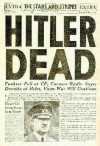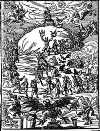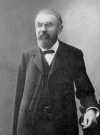 In the final days of World War II, as the Red Army of the Soviet Union was closing in on his underground bunker in Berlin, Nazi leader Adolf Hitler committed suicide by shooting himself while simultaneously biting into a cyanide capsule. Hitler’s body and that of Eva Braun—his mistress whom he had wed the day before—were then placed in a bomb crater, doused with gasoline, and set on fire by German officials. How did Soviet soldiers identify Hitler’s remains? Discuss
In the final days of World War II, as the Red Army of the Soviet Union was closing in on his underground bunker in Berlin, Nazi leader Adolf Hitler committed suicide by shooting himself while simultaneously biting into a cyanide capsule. Hitler’s body and that of Eva Braun—his mistress whom he had wed the day before—were then placed in a bomb crater, doused with gasoline, and set on fire by German officials. How did Soviet soldiers identify Hitler’s remains? Discuss
Source: The Free Dictionary
 People who lived in the
People who lived in the  In 1828, a teenage boy appeared in Nuremberg, Germany, carrying a letter that stated he had been placed in the care of the anonymous author as an infant. This caretaker claimed to have taught the boy reading, writing, and religion but never let him leave the house. The boy barely spoke but confirmed that he had been kept in a dark prison hole. In the following years, he sustained several mysterious injuries, and he was fatally stabbed in 1833. Who is thought to have been behind his death?
In 1828, a teenage boy appeared in Nuremberg, Germany, carrying a letter that stated he had been placed in the care of the anonymous author as an infant. This caretaker claimed to have taught the boy reading, writing, and religion but never let him leave the house. The boy barely spoke but confirmed that he had been kept in a dark prison hole. In the following years, he sustained several mysterious injuries, and he was fatally stabbed in 1833. Who is thought to have been behind his death?  The award-winning Toyota Prius was the world’s first commercially mass-produced and marketed hybrid automobile. Toyota’s goal for the Prius was to reduce the amount of pollutants it produced and to increase its energy efficiency. To achieve this goal, the company reduced the engine’s gasoline consumption, added two electric motor/generators, reduced air resistance and road friction, and reduced the car’s weight. Supposedly, why did Toyota choose the name “Prius” for their hybrid car?
The award-winning Toyota Prius was the world’s first commercially mass-produced and marketed hybrid automobile. Toyota’s goal for the Prius was to reduce the amount of pollutants it produced and to increase its energy efficiency. To achieve this goal, the company reduced the engine’s gasoline consumption, added two electric motor/generators, reduced air resistance and road friction, and reduced the car’s weight. Supposedly, why did Toyota choose the name “Prius” for their hybrid car?  Ernst Werner von Siemens demonstrated his Elektromote, the world’s first trolleybus, on a 591-yard (540-m) test track in a suburb of Berlin, Germany. The trolleybus was a converted four-wheel coach equipped with two electric motors. Electric power was transmitted to the coach via a flexible cable from a small, eight-wheeled “contact car” running on the power lines above. How long was the Elektromote in operation?
Ernst Werner von Siemens demonstrated his Elektromote, the world’s first trolleybus, on a 591-yard (540-m) test track in a suburb of Berlin, Germany. The trolleybus was a converted four-wheel coach equipped with two electric motors. Electric power was transmitted to the coach via a flexible cable from a small, eight-wheeled “contact car” running on the power lines above. How long was the Elektromote in operation?  This Japanese festival, held in
This Japanese festival, held in  One of the greatest mathematicians of his age, Poincaré made important contributions across the full range of mathematics, both pure and applied. He enlarged the field of mathematical physics through his work on the theory of functions, did notable work in differential equations and celestial mechanics, and also wrote extensively on the philosophy of science. He was elected to the Academy of Sciences in 1887 and the Academie Française in 1909. How many hours a day did he devote to his work?
One of the greatest mathematicians of his age, Poincaré made important contributions across the full range of mathematics, both pure and applied. He enlarged the field of mathematical physics through his work on the theory of functions, did notable work in differential equations and celestial mechanics, and also wrote extensively on the philosophy of science. He was elected to the Academy of Sciences in 1887 and the Academie Française in 1909. How many hours a day did he devote to his work? %2c_1860_-_ca._1900.jpg) A rickshaw is a small, two-wheeled carriage that is usually drawn by one person. The first rickshaws appeared in Japan around 1868 and became a popular mode of transportation because human labor was considerably cheaper than that of horses. Rickshaws were mainly used in Asia, but nowadays they are outlawed in many places and have been replaced by cycle and auto rickshaws. What is the origin of the carriage’s name?
A rickshaw is a small, two-wheeled carriage that is usually drawn by one person. The first rickshaws appeared in Japan around 1868 and became a popular mode of transportation because human labor was considerably cheaper than that of horses. Rickshaws were mainly used in Asia, but nowadays they are outlawed in many places and have been replaced by cycle and auto rickshaws. What is the origin of the carriage’s name?